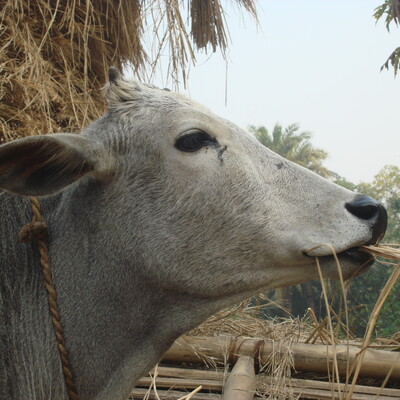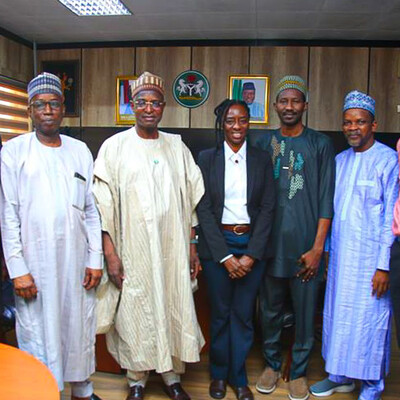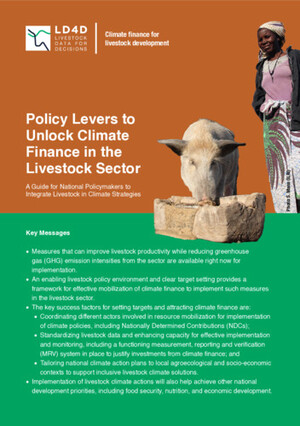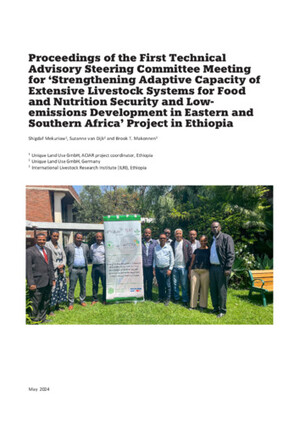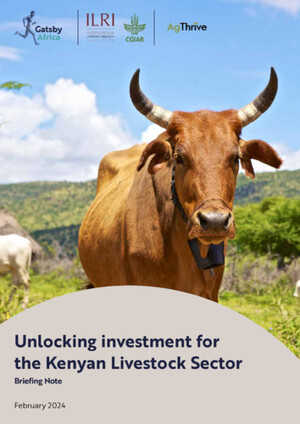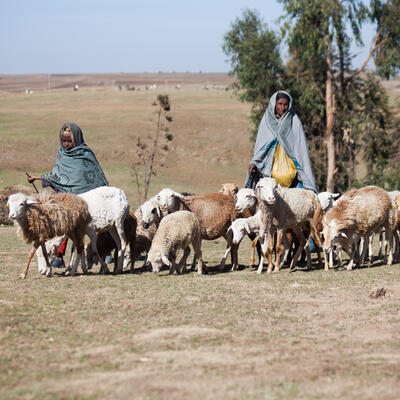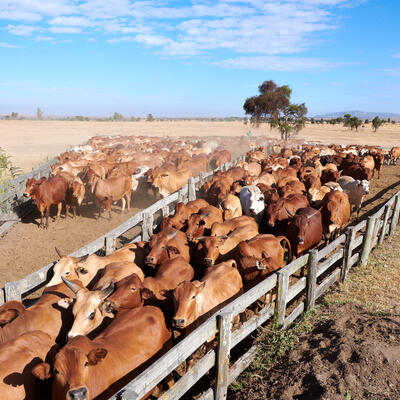
Livestock and sustainable development: Not so strange bedfellows
A week ago, the International Livestock Research Institute (ILRI) and the University of Edinburgh’s Global Academy for Agriculture and Food Security hosted a public seminar exploring how and why livestock matter as we strive to achieve the Sustainable Development Goals (SDGs). ILRI’s Michael Victor reports on the discussions.
In 2015, the world agreed to a set of SDGs to be reached by 2023—just ten years from now. However, with more than 169 targets and 230 indicators, agreement on how to define and measure progress has been challenging.
With food systems this is particularly complex. We all can agree that the goal is to transform food systems to feed ten billion people in ways that are sustainable, healthy, inclusive and efficient. Determining how best to get there and reconciling different trade-offs along the way is proving difficult.
This is especially true for cattle, sheep, goats and other farm animals whose multiple roles, benefits and risks have got caught up in polarized debates in industrialized countries, where some view them as problems rather than opportunities.
For people and communities in poorer countries, livestock remain ‘living assets’ and ‘staple goods’—sources of nutrition and income, insurance against shocks and key components of sustainable mixed crop-livestock farming systems. For the sake of global equity, then, while members of the world’s wealthier populations may want to reduce their consumption of animal-sourced meat, milk and eggs, it is critical that actions taken to achieve sustainable development include sustainably produced livestock and the nourishing foods they produce.
These issues were the subject of a seminar given by ILRI Assistant Director General Shirley Tarawali in Edinburgh last week co-sponsored by ILRI and the University of Edinburgh’s Global Academy for Agriculture and Food Security.
Tarawali’s presentation — ‘Til the cows come home: A well-worn path or a new trajectory: Exploring why livestock matter in sustainable development’ — showed how we can share the same sustainable development goals while taking different routes to reach them. She made a strong case for why livestock matter to hundreds of millions of people around the world. The world’s livestock systems, she argued, while not a panacea and certainly posing challenges as well as opportunities that must be addressed, deserve much greater attention as they make up one of several routes to achieving our common goals.
‘Extraordinary times demand extraordinary routes’, Tarawali said. ‘If multiple development challenges are to be met, and the livestock sector is to fulfil its potential, we need to recognize the value and importance of every route, because we are all aiming for that same end goal.’
Tarawali’s presentation was an opportunity to explore the paradoxes and potentials of livestock systems, particularly the smallholder livestock systems so common in developing countries, to achieving the Sustainable Development Goals. It highlighted some of the global issues and trends for the sector that need to be considered in development dialogues and presented five trajectories for how livestock can help to achieve the Sustainable Development Goals. The presentation also pointed out how the challenges and opportunities in lower- and middle-income countries, where ILRI and its partners work, are often vastly different from those in this (highly developed) part of the world.
She posited five common ‘destinations’ for sustainable global development to which livestock can make major contributions, noting that the routes to reach those destinations vary.
Among the biggest areas of contention is the environment. While many see livestock as a major problem, efficient, low-carbon sustainable livestock production can enhance rather than harm the environment. A sustainable livestock sector presents many opportunities to adapt to climate change and lower greenhouse gas emissions. The world’s many small- and medium-scale farmers, for example, can greatly reduce these emissions by making their livestock production more efficient. And that efficiency is possible without their switching to a concentrate-based livestock diet that would compete with human food production (being outstanding converters of otherwise inedible material into rich protein, livestock globally consume only 14% of the dry matter that could be used for human food). Better animal feeding, genetics and health would make a big difference in protecting environmental health—and would simultaneously improve animal welfare.
Smallholder livestock systems also offer critical pathways to help bring parity to gender relations. Women represent a large proportion of the world’s hundreds of millions livestock keepers. In some cultures, animals are the only asset that women can own. Just as women’s livelihoods in poor countries are commonly empowered through livestock enterprises, women are often responsible for transforming those enterprises into more sustainable systems. By helping women to build more lucrative work within livestock value chains (as entrepreneurs, business women and traders) and to take larger roles in livestock research innovation work, greater gender equality can be achieved.
When it comes to food consumption, the disparities between higher and lower income countries are striking. In relatively rich countries, where excessive consumption of food, including meat, is a driver of obesity and environmental harm, such consumption should be curtailed to improve both human and environmental health. And there already exist in these countries healthy (if not always cheap) alternatives to meat. In lower-income countries, on the other hand, modest amounts of animal-sourced foods remain essential for the adequate nutrition and long-term health of the great majority of the population. The challenge here is to ensure affordable, accessible, balanced, nutritious diets that include the choice of healthy livestock-derived foods.
With the outbreak of the new coronavirus in China (now dubbed ‘COVID-19’), there are heightened concerns about the intersection of animal and human health. In every country there are very big opportunities for much closer coordination and cooperation between animal, public and environmental health disciplines and work. Such a so-called ‘One Health’ approach can be taken to prevent or stop such disease threats. Stopping the transmission of infectious pathogens from animals to humans is much easier, and far less costly, to do in animals before they have the chance to jump to people. One study has indicated that a global investment of USD25 billion over ten years in One Health work would generate benefits worth at least USD125 billion.
Finally, livestock present pathways to prosperity. Livestock are fundamental for the livelihoods of almost one in five people on the planet and in virtually every country on earth, for national economic growth In LMICs more than half a billion people are dependent on livestock. That cannot continue as farms transition to consolidate, to become more efficient not all these people will remain connected to the livestock sector. The challenge of course is to make sure that there are viable livelihood options that allow such transitions and provide for the multiple roles that livestock support today.

In the discussion that followed the presentation, a key issue raised was that of trade-offs between livestock, environment and diets. There is no one-size solution for each country. A member of the (Edinburgh) audience asked whether Scotland, which has efficient livestock systems, should focus on livestock exports. Tarawali answered that such issues should be analysed from different angles, such as the transport, environment and financial costs, as well as the impacts on local livestock systems.
Another issue was how to scale up smallholder livestock systems while protecting biodiversity and not moving to unsustainable industrial livestock systems. It was mentioned that while it is possible to grow smallholder livestock systems while protecting the environment and biodiversity, there are likely to be trade-offs to be considered, such as less-efficient livestock value chains and higher consumer costs for livestock products.
Tarawali’s presentation reminded me of a discussion I once had with a Brahmin priest as I was making my way to a sacred area called Muktinath, in Nepal. He said there are many paths to get to the top; ‘There is not just “one way”; we should respect the different ways that people take to get there.’
The overriding point I take from these discussions is not to exclude livestock from discussions on sustainable development but rather to make sure that livestock options are part of the solutions on offer.
More information:
- Watch a recording of the seminar
- Download the presentation
- Why livestock matter – website making the case to invest in sustainable livestock
We thank the Global Academy for Agriculture and Food Security and the ‘Supporting Evidence-Based Interventions’ (SEBI) project for their collabation and support.






